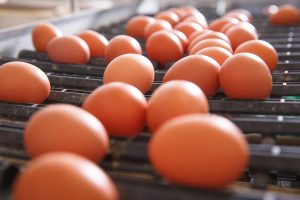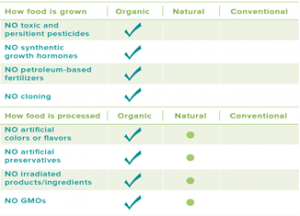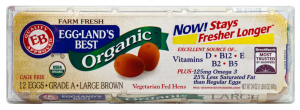Problematic Production
The Deceptible, Unequable Egg
Sandra Evans

For years I have been going to Kroger with the handful of coupons that Kroger so graciously sends me roughly once a month and choosing the cheapest carton of eggs that I can get. At Kroger, the price for eggs is suspiciously low once you consider the price per egg after using a 40 cents off coupon for an eighteen-count carton of Kroger-brand eggs. The total averages out to roughly 6 cents an egg. I pay almost double that for a stick of gum. With a price that low, I never truly considered my other options which are priced up to nearly $7 a dozen, a stark comparison to Kroger-brand. If I were to prepare two eggs for breakfast, the Kroger brand would cost me a measly 12 cents while a brand like Eggland’s Best organic would cost about 92 cents. That is over seven times as much and is a difference that adds up substantially over several meals. With packaging shouting out cage-free, enriched, pasture-raised, organic, many people have no idea what is truly behind these buzzwords. With such variances in price, there should be evident differences in the ethics and nutrition between the cheapest eggs and the higher priced ones. On the pursuit for what makes a better-quality egg, I will be drawing comparisons between Kroger-brand eggs, a higher priced store-bought option, and local farm eggs.

Pulled from organicitsworthit.org
Kroger has roughly five different store-brand eggs with four of those being from their affordable, healthy line, “Simple Truth.” The variation in terminology used on the packaging between the different Simple Truth eggs provides a template to consider what different terms mean and whether they are regulated. The price for a dozen of these store-brand eggs ranges from $0.99 for the basic Kroger brand to $4.49 for the Simple Truth pasture raised eggs. The term “pasture raised” should imply that the animals were allowed outside, but this term is not regulated by the USDA and there is little to determine whether this description is factual (Carlson, 2019). Two of the cheaper eggs that fall between that range at $2.99 a dozen utilize the terms “natural” and “cage free.” One would assume that “natural” would mean less processing as well as little to no antibiotics or hormones, but there are currently no regulations from the USDA or FDA on the usage of this word, therefore anyone can assert it (Natural vs. Organic). The term “cage free,” is regulated by the USDA, but does not mean that the chickens are allowed outside or are in humane conditions, just that they are not kept in cages (Carlson, 2019). Because there are no regulations on using the term natural and that the term cage free has loose requirements, it makes sense that Kroger’s cheaper, supposedly healthier options are advertised to the consumer in these ways. The second most expensive store-brand option, Simple Truth organic cage free eggs, are priced at $3.99 and bear the USDA organic seal which is the most highly regulated term that requires that “products sold, labeled, or represented as organic must have at least 95 percent certified organic content” (USDA, AMS, 2020). With only one term being highly regulated, and cage-free being regulated only to its most literal sense, there is a great deal of slack for producers to advertise their eggs in an inaccurate light.

The living conditions of hens that are used to mass produce eggs varies but is still very much the same. The hens laying the Kroger brand eggs that do not specify whether they are cage free or pasture raised are kept in barns in small battery cages that have only 67 square inches of space, which is less than a piece of letter-sized paper at 93.5 square inches (The Humane Society). These barns house hundreds of hens in long rows of cages and often do not have any windows. The hens are either kept in the dark or in artificial light when people come in to remove eggs from the cages. Cage free is a similar picture with hundreds of chickens in overcrowded barns with barely enough room to move around. These chickens may have access to a limited outdoor area, but with the number of hens competing to get to the entrance of the outdoor space, it is unlikely that each hen in “It is unlikely that each hen in the barn will be able to experience the outdoors.”the barn will be able to experience the outdoors (Gelles, 2016). Pasture raised is the most humane living situation for hens when they are subjected to mass egg production. Ideally, these hens can forage on insects and greenery, but there are no regulations to ensure that the hens are not being kept in small cages or in overcrowded barns (Carlson, 2019). Whether the hens are in cages or loose in barns, the overcrowded conditions and lack of exposure to the outdoors is consistent within the egg industry.
Among the higher priced options at the grocery store, Eggland’s Best has always caught my eye in a confusing way – why would a package of eggs need to advertise to the consumer in so many ways? Eggland’s Best Organic Grade A Large Brown Eggs priced at $5.49 provides an excellent model to investigate the nutritional components of an egg as well as consumer trends.

One of the seemingly outlandish claims that Eggland’s Best uses on their packaging is that their egg “Now stays fresh longer!” When I delved deeper and visited their website, they state that there are multiple reasons that their eggs do in fact stay fresh longer than the traditional egg. The first being that their eggs “are placed in refrigerated storage within 24 hours of being laid and are packed within seven days.” Their claim of “farm fresh” is tied to their longer shelf-life as they state on their website that their eggs are considered farm fresh when they are delivered to the store within 72 hours of being laid. They make a point to include that most egg producers allow eggs to sit in storage for up to three weeks before packaging! In addition to getting their eggs to the stores sooner, they state that their hens are fed “superior amounts of minerals and vitamins, which leads to greater eggshell strength,” and that their feed does not contain animal products or by-products which is included on their label as “vegetarian-fed hens” (Eggland’s Best, 2016). While this claim seemed too good to be true, there is sound science and reasoning behind it. Although, as a consumer you cannot be certain that these eggs are made available to you at the store within their 72-hour constraint or that the hens are fed this specific diet because there is no government supervision to ensure either.
“The perfect food just became more perfect.” – Charlie Lanktree, Eggland’s Best President and CEO (2006) Their packaging makes a considerable number of claims regarding the nutritional superiority of their eggs, including additional vitamins and omega-3s and less saturated fats. These claims do have a concrete basis as an egg can have added vitamin D from the hen having exposure to sun and additional vitamins D, B12, E, B2, and B5 from what is in their feed (Yao et al, 2013). In an ideal world, this added amount of vitamin D would come from the hens being able to spend time in the sun, but their packaging states “cage-free” rather than “pasture raised”, which as mentioned before is not a guarantee that the hens are allowed outside. Similarly, their eggs can have higher amounts of omega-3s by being fed a diet that is rich in omega-3 fatty acids which could be from feeding the hens ground flaxseed or flaxseed oil (Ehr et al, 2017). Like the added vitamins and omega-3s, Eggland’s best is also able to have “25% less saturated fat than regular eggs” by feeding their hens a diet with less saturated fats. This nutritional tactic is patented by Eggland’s Best with the title “Egg Compatible With Cholesterol Reducing Diet and Method of Producing the Same.” In 2006 Charlie Lanktree, Eggland’s Best president and CEO, said that “the perfect food just became more perfect.” Lanktree also joked that the hens eat a better diet than he does, but there is no regulation on the diet that a hen is fed other than the USDA organic seal (Evans, 2006). Additionally, the FDA’s website states that, “nutrition labeling for raw produce (fruits and vegetables) and fish is voluntary” (Center for Food Safety and Applied Nutrition, FDA, 2020). However, there are “requirements that govern the use of nutrient content claims [to] help ensure that descriptive terms, such as high or low, are used consistently for all types of food products and are thus meaningful to consumers.” (Center for Food Safety and Applied Nutrition, FDA, 2020). Claiming that the eggs are an excellent source of vitamins and omega-3’s is allowed to be printed without regulation, but the statement about having less saturated fats comes with tighter margins.
“This farm’s hens are not just livestock, they are family pets with names.”An interesting component flaunted on the Eggland’s Best packaging is the BrandSpark seal. BrandSpark is a market research firm that surveys consumers to find which brands that they trust the most. Their website says that they are “the voice of the consumer,” but do these consumers know the regulations and the parameters surrounding the products that they put their alleged trust in? Eggland’s Best offers a plethora of information on their packaging that sounds ethical and nutritiously promising, but there is scarce regulation for these claims. Unless the consumer can transform into a fly on the wall where Eggland’s Best keeps some of their hens, then there is no way of truly knowing whether there is a firm foundation behind their unregulated assertions. This is not to say that Eggland’s Best is completely baseless in all their claims that are not regulated by the FDA or the USDA, but there is a reasonable possibility that they are not being completely transparent to their consumers which poses a breach in the trust that a significant number of shoppers have placed in them.
To give a better perspective on the treatment of hens, I found a local farm that raises chickens and sells eggs for $5 a dozen from their front porch. Prior to visiting, I read from their internet listing that their hens are free-to-forage and that “[their] chickens hunt for bugs and worms and eat delicious clover (Find a Farm).” When hens forage, they intake beneficial nutrients from the bugs and plant-life that they consume which is reflected in the nutritional components of the eggs that they lay (Samiullah et al, 2015). When the chickens are not foraging, they are fed non-GMO feed as well as the occasional table scraps from the family. These chickens are also not subjected to antibiotics and hormones. The hens have a clean, roomy coop and the farm limits their flock sizes to about eight hens to ensure that each of their hens have uncompetitive access to space and food. This is a sharp contrast to the mass egg producers that keep hundreds of hens in small, battery cages, or in the case of many cage-free producers, in crowded barns with limited outdoor space where the hens are so concentrated that they barely have room to walk around (Gelles, 2016). This farm’s hens are not just livestock, they are family pets with names that are thoughtfully tended to and cared for. These chickens have a life worth living while they provide their owners with fresh eggs each day.
When I investigated what makes a better egg, I considered two things that were going to determine value, the ethical implications as well as the superior nutrition. When it comes to buying eggs at a grocery store there is no guarantee that you will get either. There is an information asymmetry in which consumers cannot be certain if they are paying for ethical, nutritious food. Between loose regulations and no regulations at all, labels can be incredibly deceiving. The treatment of hens where the mass production of eggs takes place is far from humane where a vast majority of the hens are kept in small cages or in overly crowded barns. These conditions have negative impacts on the hen’s health which is ultimately reflected in the nutritional quality of the eggs that they lay. I have always been under the belief that additional government regulation is never a good thing, but with food being intimately connected to us as we put it into our bodies and serve it to our families, the discrepancies between what we are being disclosed on a package and what we are consuming needs to be narrowed. With the regulations that are currently in place, the only guaranteed claim is the USDA’s organic seal. Our foods need more than one seal to fully inform us of how the items that we consume, particularly animal based, are being treated and processed.
“The extra 80 cents at breakfast is worth it.”
Prior to starting my research, I decided to compare the cheapest Kroger brand eggs that I would typically buy with the Eggland’s Best Organic, my husband and I could both tell a difference and have not bought the Kroger brand since. Cheap eggs come with a heavy price that is put on the hens and the consumer; hens are mistreated, and consumers do not get the same quality taste or nutrition that can be found in higher priced eggs particularly from local, small farms. As consumers, we have the power to support the brands that we deem ethical and of quality. We can choose whether we continue our support to systems that perpetrate inhumane conditions to animals and choose to favor quality over quantity. The extra 80 cents at breakfast is worth it.
References
Anderson, K. (2018). Food Facts: What is the difference between white and brown eggs? Best Food Facts. Retrieved November 14, 2020, from https://www.bestfoodfacts.org/food-facts-what-is-the-difference-between-white-and-brown-eggs/
Carlson, C. (2019, June 13). What Do Cage-Free, Free-Range and Pasture-Raised Eggs Mean? Retrieved November 14, 2020, from https://www.organicvalley.coop/blog/what-do-cage-free-free-range-and-pasture-raised-mean/
Eggland’s Best. (2016, December 2). How Can You Tell If Your Eggs Are Fresh. Retrieved November 14, 2020, from https://www.egglandsbest.com/news/can-tell-eggs-fresh
Ehr, I., Persia, M., & Bobeck, E. (2017). Comparative omega-3 fatty acid enrichment of egg yolks from first-cycle laying hens fed flaxseed oil or ground flaxseed. Poultry Science, 96(6), 1791-1799. doi:10.3382/ps/pew462
Evans, M. (2006, April 6). Healthy hens hatch success for Eggland’s Best. NBC News. Retrieved November 14, 2020, from https://www.nbcnews.com/id/wbna12172154
FDA, Center for Food Safety and Applied Nutrition. (2020). Food Labeling & Nutrition. Retrieved November 19, 2020, from https://www.fda.gov/food/food-labeling-nutrition
FDA, Center for Food Safety and Applied Nutrition. (2020). Label Claims for Conventional Foods and Dietary Supplements. Retrieved November 19, 2020, from https://www.fda.gov/food/food-labeling-nutrition/label-claims-conventional-foods-and-dietary-supplements
Gelles, D. (2016, July 16). Eggs That Clear the Cages, but Maybe Not the Conscience. The New York Times. Retrieved November 29, 2020, from https://www.nytimes.com/2016/07/17/business/eggs-that-clear-the-cages-but-maybe-not-the-conscience.html
Natural vs. Organic. (n.d.). Retrieved November 8, 2020, from http://www.organicitsworthit.org/natural/natural-vs-organic
Find a Farm. (n.d.). Retrieved November 14, 2020, from https://localhens.com
Samiullah, S., Roberts, J., & Chousalkar, K. (2015). Eggshell color in brown-egg laying hens – a review [Abstract]. Poultry Science, 94(10). doi:10.3382/ps/pev202
The Humane Society of the United States. (n.d.). Cage-free vs. battery-cage eggs. Retrieved December 01, 2020, from https://www.humanesociety.org/resources/cage-free-vs-battery-cage-eggs
USDA, AMS. (2020). Organic. Retrieved November 20, 2020, from https://www.ams.usda.gov/grades-standards/organic-standards
Yao, L., Wang, T., Persia, M., Horst, R. L., & Higgins, M. (2013). Effects of Vitamin D3-Enriched Diet on Egg Yolk Vitamin D3Content and Yolk Quality [Abstract]. Journal of Food Science, 78(2). doi:10.1111/1750-3841.12032
